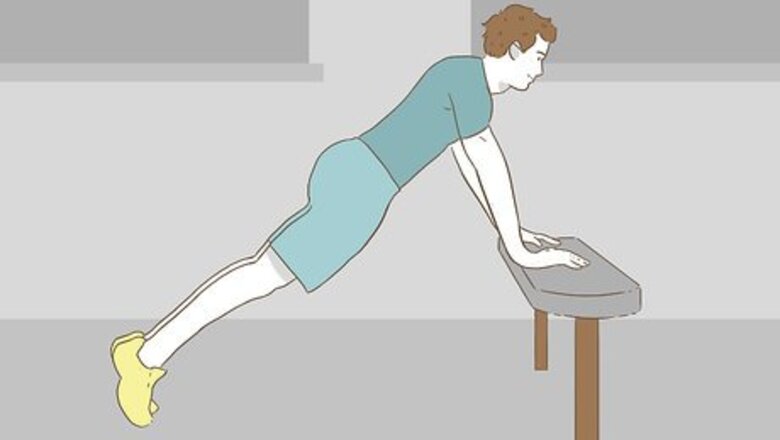
views
X
Expert Source
Julian Arana, M.S.eD., NCSF-CPTCertified Personal Trainer
Expert Interview. 19 May 2020.
Read on for more tips and strength-building exercises.
- Start by taking the standard push-up position: prone, feet apart, and hands on the floor just below your shoulders.
- Slowly lower your body with 1 arm, turning your torso slightly away from the supporting arm, and form a sort of triangle with your arm and two feet to help you balance.
- Push your body up from the floor to the starting position, keeping your back straight and stopping just before you “lock out” at the elbow.
Starting with Elevated Push-ups
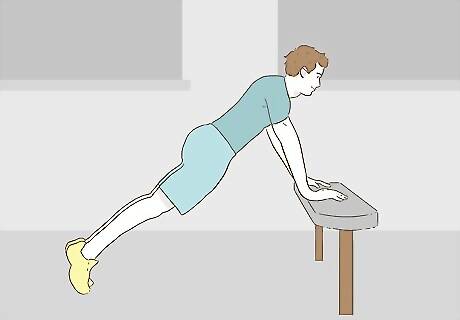
Find an elevated surface. Elevated one-armed push-ups are a good way to start. The idea is that by using a raised surface, your legs take on more body weight and give you a mechanical advantage. The push-up is therefore easier to accomplish. Try a countertop, steps, couch, or wall at home. If you are outdoors, a bench or bar will do. Keep in mind that the higher you angle your body, the more body weight your legs will support and the easier the push-up will be. Don’t overdo it. Find a surface and inclination that suit your current strength level and work from there.
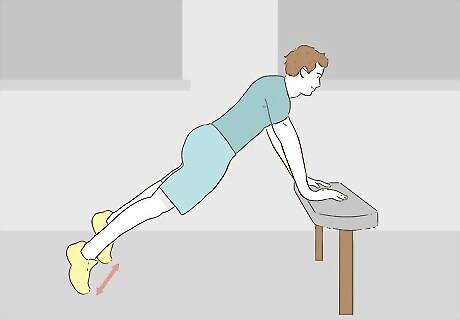
Lean in with your feet spread apart. Besides inclination, your feet will also make a difference. Namely, the push-up will be easier if they are wider apart. Stand with your feet positioned a bit wider than your shoulders, and slowly lower yourself into push-up position on the elevated surface. Some purists think that one-armed push-ups should be done with the feet together. You don’t need to follow this rule absolutely. You can also start wide and gradually move your feet inward as you progress. It’s a good idea to start with your “dominant” arm. In other words, whichever arm you favor and that is naturally stronger. You can alternate arms, as well. As you get in a starting position, let your free arm rest behind your back or against one leg.
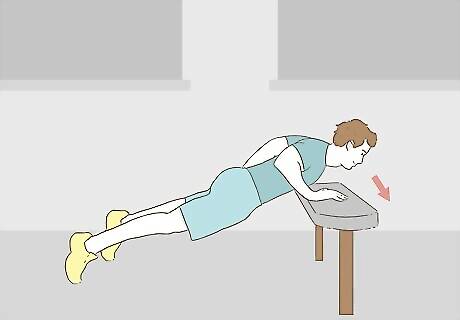
Lower yourself. Slowly and deliberately lower your body until your chest almost touches the elevated surface. Your supporting arm should be bent at an acute angle of less than 90 degrees. If you want, hold this position for a few seconds. Some people advise keeping your whole body tense during the downward motion. This is supposed to help you explode upward. It will also keep your spine straight and reduce the risk of injury. Keep your bent arm back and close to your body, not jutting out like a chicken wing. Flaring your elbow out can lead to shoulder and rotator cuff injuries. Brace your abs and clench your gluteal muscles — that is, the muscles around your torso and bum.
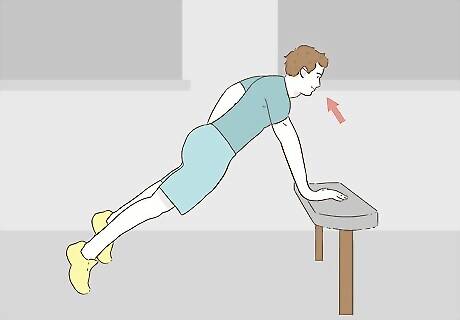
Push upward. Push away from the incline and back to the starting position in a single, fluid motion. The body tension you have generated before and during this move should help you to explode upward and finish the first “rep.” Imagine that you are pushing the floor away rather than pushing yourself up. This image should let you generate more tension and engage more muscle groups.
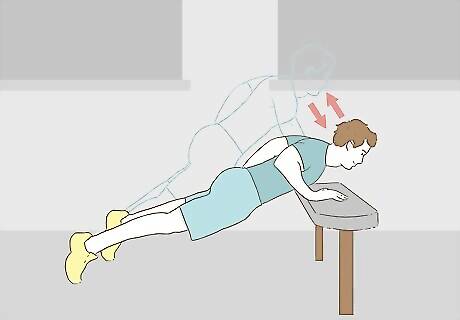
Repeat and change sides. Repeat the above steps and complete a full set of reps. Then, switch to the other side. For instance, if you started with right-armed push-ups, try it with your left arm. Adjust your elevation height to suit any differences in strength. Try to do about six reps comfortably in a set to start. In other words, you should be able to do the full push-up motion in good form. If you are bold, try another set of reps after resting a few hours. Doing the reps while fresh will encourage you to use good form and build up greater power and endurance. Once you feel good at a certain level, lower the inclination and raise the weight resistance. Continue to repeat these steps until you have reached the ground.
Building Strength with Self-Assisted Push-ups
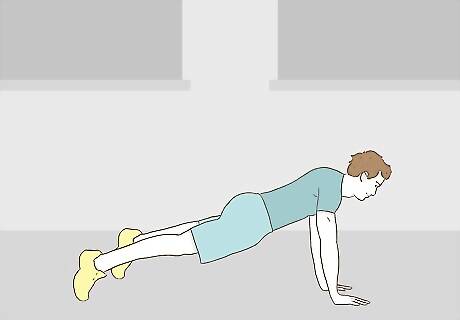
Lower yourself to the ground on two hands. The next step in your progression is to do “self-assisted” push-ups. These are almost true one-handed push-ups, but with small cheats to let you build up more strength. First, lower yourself slowly to the ground with both hands. These push-ups are done level to the ground, rather than on an elevated surface. Assume a position as if you were going to do normal, two-handed push-ups. Again, make sure to keep your feet slightly wider than your shoulders.
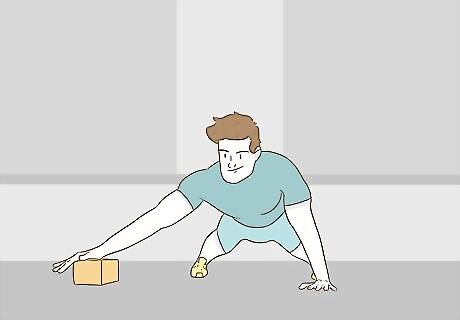
Extend your secondary arm outward. Reach out — up and to the side — with your secondary arm, i.e. the arm that will not be supporting your body. The idea is to let this free arm “assist” in the push-up by taking on a small amount of weight, but to rely on it as little as possible. Over time, you will build up strength and come to rely on it even less. You can also place the assisting arm on a slightly elevated surface.
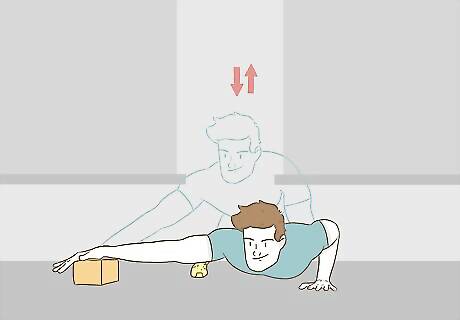
Lower and raise yourself. As before, slowly lower your body until your chest is nearly touching the ground and your supporting arm is at an acute angle. However, be very careful about how low you go and how far your shoulder is extended because there is a risk of injury. Once you are in position, try to explode upward in a single and fluid motion. You may have trouble at first with raising yourself. That is OK. Simply shift some body weight to the assisting arm. You can also try widening your foot stance. Again, keep your core muscles tight through the motion to create body tension and protect your spine. Keep your elbow in (no chicken wings), and pull your shoulder blades down and back

Try a “negative” one-armed push-up, alternately. Another move that can build up your strength and perfect your form is the “negative” push-up. This means focusing on the negative or lowering phase. At this point, you are nearly at the true one-armed push-up. Use one arm for this maneuver. Keep your free arm behind your back. From the starting position, lower yourself to the ground. Move as slowly as you can and keep control over the movement. When you reach the bottom, place your free hand on the ground and push up. Continue with your set.
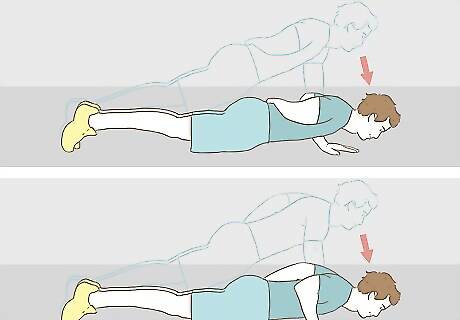
Repeat and change sides. Whether you try the self-assisted or negative one-armed push-up, make sure to switch it up and use your other arm. You can also alternate arms for each rep rather than doing a full set. It is important to use both arms to avoid creating muscle imbalances or differences in strength.
Doing a True One-Armed Push-up
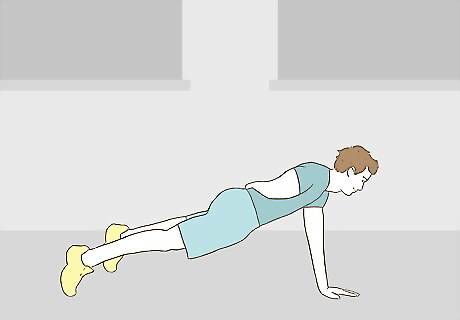
Assume the position. OK, you know what to do by now. Take the standard push-up position: prone, feet apart, and hands on the floor just below your shoulders. Begin from the “up” position, i.e. with your body raised off the ground and supported by your arm. Keep your back straight and do not twist your torso at all when you are raising or lowering it. Keep your feet apart. If you want to increase the challenge, though, feel free to move your feet in so that they nearly touch. Take your off-arm and rest it on the small of your back. In a resting position, the elbow of your supporting arm should be slightly bent, not locked.
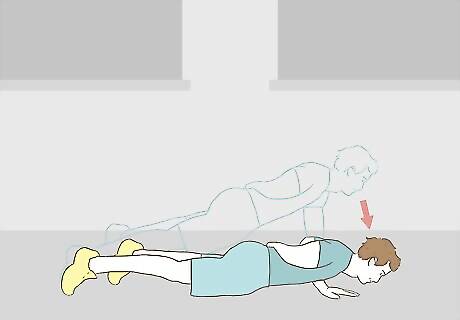
Lower your body with one arm. Let your body move toward the ground. Be sure to control the movement as much as you can. It should be slow and deliberate, not strained or jerky. Continue until your chin is about a fist’s width above the floor. To maintain your balance better, Turning your torso slightly away from the supporting arm, form a sort of triangle with your arm and two feet, can help you keep your balance. Keeping your hips and shoulders square throughout the movement will be more challenging. Either way, do not let your hips sag. If you’ve angled your body, your chin will be about where your free hand was before you started the exercise. Remember to keep your elbow back and close to your body and do not allow it to flare out. Keep your shoulder blades retracted.

Push up from the floor. Now, with all your might, push your body up from the floor to the starting position. Make sure to keep your back straight and to stop just before you “lock out” at the elbow. Congratulations! You’ve now done a true, one-armed push-up! Keep your muscle tightened as before, so that it is possible for you to “explode” upward. Be careful to stop if you don’t think you can make it. You could injure yourself if your arm gives out.
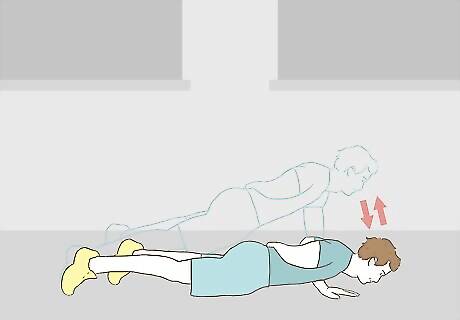
Repeat, if you’re up to it. Ideally, your first true one arm will be the first of many. Try to do it with your other arm and see if you can manage a set of two, three, or more. Continue to go slowly. Start with reps of one or two. Rest for several hours before trying again. Over time, you should be able to work up to higher and higher rep numbers — repeat to exhaustion for an intense arm and chest workout!



















Comments
0 comment